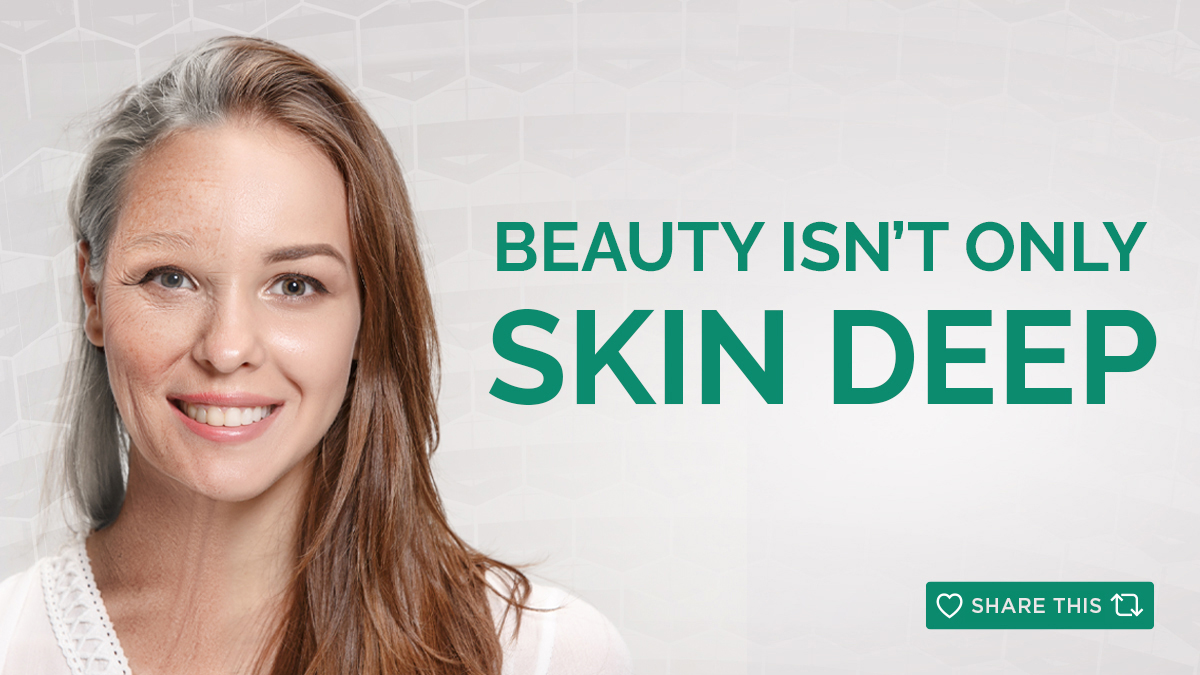It Isn’t Only Skin Deep

Hey, we all want to look and feel our best, right? And there’s usually room for improvement. And, the good news is, it’s never too late to start. As one of my oldest friends from high school, Michael Martin says, “take what you got; do what you can; and start right now”.
Another saying goes, “Beauty is only skin deep.” Well, not necessarily. Research shows that if you look better, you feel better, and you’re more confident. Feeling secure in your own skin frees up your mind to be a person that can be empathetic to and help others. The two things aren’t mutually exclusive. You can look good and feel good at the same time.
The thing is, for some reason, society has often looked down on using science to improve our physicality. It’s strange, really. We use medical approaches to fight illness and disease, but when we use this same methodology to fight the outward signs of aging, there’s a stigma attached. What’s so wrong with wanting to live longer and feel better about our appearance? Why is it considered vain to want to live your best life? People who look good and feel good are generally more productive, so why not get a leg up from science.
Here’s what we’re talking about.
Stem Cell Therapy
With stem cell therapy, the goal is to slow down the aging process. This can be done by replacing “senesced” (dying and dyfunctional) cells with healthy ones. Adults have extra stem cells in all sorts of places, like in fatty tissue and bone marrow. All we have to do is harvest these healthy stem cells, even expand (replicate them in a lab) them, and then use them in stem cell therapy procedures. It’s kind of like drinking a sports drink to replace your electrolytes after a tough workout. But in the case of stem cells, you’re simply replacing damaged and dying cells so that the news cells derived from stem cells can get to work to regenerating organs and rejuvenating your body as a whole.
It’s really not as taboo as some would like you to think. Some of the controversy arises when stem cells are taken from the umbilical cord of a baby. Well, that’s just not necessary, and the fact that we can use stem cells from adults as described above is really old news.
The saying goes, “Beauty is only skin deep,” but that’s not necessarily true. Research shows that if you look better, you feel better, and you’re more confident. Feeling secure in your own skin frees up your mind to be a person that can be empathetic to and help others. The two things aren’t mutually exclusive. You can look good and feel good at the same time.
Dr. Rand McClain
Stem cells can do more than just help with anti-aging. Regenerative stem cell therapy can increase feelings of vitality and libido, reduce pain, make your hair thicker and more luxurious, increase muscle and tendon strength and strengthen immunity. Elite athletes use stem cell therapy to treat injuries as well as to prevent further injuries down the road.
One of the goals we often share is to age gracefully. We have the tools and resources to make that an option through stem cell therapy. It’s only a matter of taking advantage of the tools available.
Hormone Replacement
Aging is particularly hard on women as their hormones – a combination of their decrease as well as imbalance – begin to wreak havoc on their energy levels, libido, sleep, and body composition during menopause and perimenopause. It can become increasingly frustrating and affect their quality of life and relationships.
That’s where hormone replacement therapy (HRT) comes in to save the day. Using synthesized hormones that are identical to human hormones, physicians can bring the equilibrium back to hormone levels that have gone haywire – a “normal” process of aging.
HRT is all about reducing the symptoms that make women feel uncomfortable in their own bodies. It can help to restore a youthful appearance as well as activity level. But that’s not all. HRT can reduce the risk of coronary heart disease, adult-onset diabetes, colon cancer, and osteoporosis.
That being said, HRT isn’t a one size fits all approach. Just like everything else, it’s important to consult with your physician. Some patients can see adverse reactions to the varying types of HRT, especially depending on medical history, but almost invariably, these side effects can be treated and resolved without having to discontinue therapy.
Testosterone is typically essential to any hormone replacement therapy in which the chief complaints are a decrease in energy, libido, mental acuity, sense of well-being and lean body composition. Most think of testosterone as a strictly male or “masculine” hormone but it is actually present in and essential for both genders and for the same purposes.
Boosting testosterone levels can improve heart function and blood flow, and replaced testosterone levels can also enhance verbal memory, spatial abilities, and mathematical reasoning. In fact, research shows that those with higher testosterone levels have a reduced incidence of Alzheimer’s disease.
Where to start? A simple blood test can determine testosterone levels. If levels are low and you’re experiencing symptoms, your doctor may recommend testosterone therapy, which is a synthesized – preferably bioidentical – testosterone replacement to increase those levels. The therapy can come in the form of an injection, gel, patch, surgically implanted pellet, or oral tablet or capsule.
As always, consult with a physician before going down this route.
There’s nothing wrong with wanting to look and feel your best. There are natural methods that should be encouraged, but there’s also a wealth of medical approaches that can also be beneficial. Why not use everything that’s in our arsenal to live life to the fullest? I know I will.